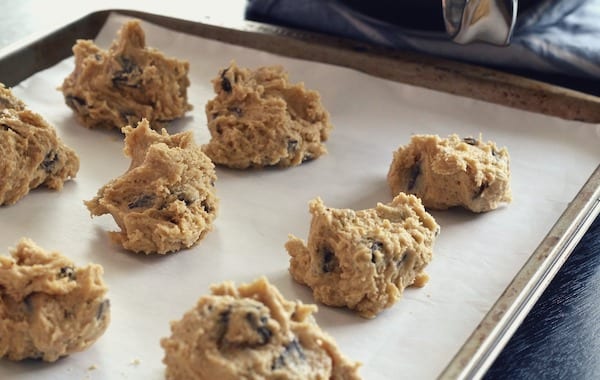Who doesn’t love cookies? Baby boomers, older adults, and even dietitians enjoy these timeless bite-sized goodies. In fact, Americans love them so much, we even have a national day named after them, and it’s celebrated on December 4.
Now you may be thinking—a dietitian endorsing cookies? Hmmm… How could a nutrition professional fit the words “cookie” and “healthy” in the same sentence? Well here’s the thing—I do enjoy both baking and consuming cookies, and I’m frequently looking for ways to help people fit their favorite foods into their diet in some fashion or another. So I like to put these two words together: “healthier cookies!”
And I always keep in mind my 80/20 rule. That is, consistently engage in healthful behaviors at least 80% of the time. The other 20% is for activities that feed your soul in a different way, whether it’s relaxing with your favorite Netflix shows or indulging in decadent desserts.
So here are this dietitian’s suggestions for making your favorite cookies a bit more health-friendly this holiday season.
Substitute this for that:
Whole wheat for white flour
There’s not a lot of positive qualities we dietitians can attribute to white flour. In the refining process, the bran and wheat germ are removed, along with their fiber and nutrients. However, it is the base for most cookie recipes. Substituting part of this ingredient with whole wheat flour will add some valuable fiber, as well as missing minerals and vitamins.
Best practice:
Start by substituting 1/4 to 1/2 of the flour amount with whole wheat (you can work up to 100% replacement).
Gluten-free flour for wheat flour
Our daughter has celiac disease, and we’ve explored gluten-free flour versions for many years. There are several g-free baking mixes on the market, as well as flours made from coconut, almond, and other ingredients.
Best practice:
You’ll need to test these out before you settle on a favorite, because some of the brands have an aftertaste, a strange texture, or produce a flatter cookie. Others produce a very acceptable cookie.
Plant-based spreads/margarines for butter
For a vegan cookie, you can use margarines for butter. You may get a flatter cookie, so again, experimenting is always good.
Best practice:
Substitute your favorite plant-based spread for butter, on a one-for-one basis.
Applesauce or smashed banana for butter
If you’re looking to cut down on total fat, these fruits are a great alternative. Note that their flavor and texture will come through, so choose these recipes wisely. Applesauce and bananas will also add fiber and nutrients not available in butter.
Best practice:
Substitute half the butter with your fruit of choice.
Flaxseed meal for eggs
Again, for the vegans, this is a very easy and acceptable substitution. You’ll lose the cholesterol of the eggs, and gain some fiber in the flaxseed.
Best practice:
The basic “recipe” is 1 egg = 1 Tb. flaxseed meal with 3 Tb. water. Put the mixture in the refrigerator for a few minutes to thicken up, and be sure to stir before adding to other ingredients.
Homemade recipes for store-bought mixes
Take the time to put together your own cookie recipes, and pass on all the additives and ingredients that keep the cookies tasting ok after being on the shelf for who knows how long. Plus, you’ll have 100% control over the amount of fats and sugars that go into your goodies.
Best practice:
Plan ahead to make sure you have all the ingredients you need.
Use less of these:
Butter
If you must have the texture and flavor of butter, many cookie recipes taste just fine with less of this fat. In fact, I make my favorite chocolate chip version with half the butter called for (one stick of butter vs. two).
Best practice:
Experiment with your favorite recipes. Start by cutting fat by 25%, and see if you can work your way up to 50%. Note that cookies will not spread as much with less butter, but if you enjoy a denser, chunkier version, this will work.
Sugar
You can find many substitutes in this baking category (coconut sugar, agave, honey, stevia), but you may want to start by cutting back on the amount of granulated (white) sugar. Note that sugar is a browning agent, and decreasing too much will affect color, sweetness, and texture .
Best practice:
Cut sugar by 1/4 to start. Gradually decrease more if the end result is satisfactory. If you need a little extra sweetness after cutting back, sprinkle a tiny amount on top of each cookie.
Chocolate chips
You may have guessed by now that chocolate chip cookies are my all-time favorite. But cutting back on the namesake ingredient still makes a delicious snack, and cuts lots of calories.
Best practice:
Decrease the amount of chocolate chips in half, you’ll be fine.
Healthful ingredients:
(The following all add fiber, vitamins, minerals, and antioxidants to your cookies.)
Nuts
Nuts are high in fiber, heart-healthy fats, and minerals.
Oatmeal
Oatmeal adds good-for-your-heart dietary fiber and minerals.
Dried fruits
Cranberries and raisins add fiber, vitamins, and antioxidants. But they are generally high in sugar, so you may need to cut back on the granulated sugar used.
Best practice:
Follow the recipe or add a 1/4 cup to your favorite cookie dough.
For other healthful eating ideas, please reach out to me.

